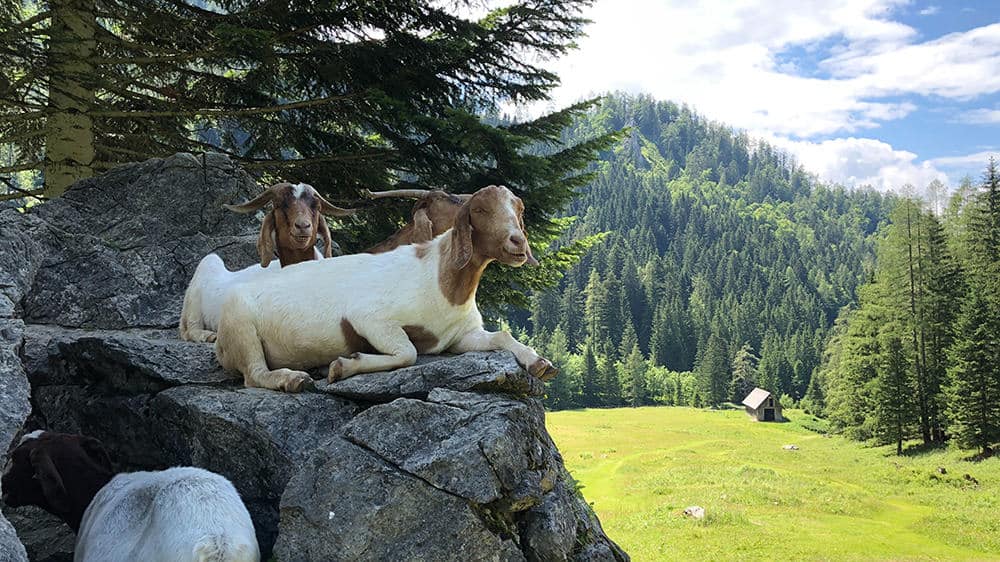
Updated April 19th, 2021
Enrichment is often thought of as an “extra” or optional provision for residents. Sanctuary staff are understandably focused on providing the food, water, and housing that is necessary for residents to live. However, we are hoping that by incorporating enrichment as an aspect of general care, the lives of residents will be enriched. This is of particular importance for residents residing in smaller, more confined, or barren living spaces. In areas that experience intense cold, the best way to keep goat residents warm is to leave them in a smaller indoor living space when they may normally have a larger outdoor space for foraging and other goat behaviors. In cases like these, enrichment can make a world of difference in the lives of residents. No one likes to be bored, including residents, regardless of species!
Safety First!
There are some unique safety challenges associated with goats that are important to keep in mind when planning enrichment. To learn more about these challenges and specific hazards you should be aware of, check out our Goat Resident Safety series.
Developing An Enrichment Plan
It is important to understand the species-specific needs of your residents, in addition to considering their individual needs. An example of a species-specific understanding acknowledges that goats are curious browsers with an aptitude for climbing, and that needs to be taken into consideration when developing an enrichment plan.
For example: On an individual level, consider Harley. He’s a lanky, older fella who has some mobility issues after a recent amputation and subsequent prosthesis fitting. He is going to need to live apart from the main herd for a couple weeks. Setting Harley up in a smaller or augmented living spaceThe indoor or outdoor area where an animal resident lives, eats, and rests. will be necessary, and providing enrichment as a means of mental stimulation can assist in his healing. Examples of possible enrichment strategies for Harley include providing social enrichment, either by allowing a calm goat friend to stay with him during his recovery period, or, if that isn’t possible, allowing Harley visual and physical contact through a fence. You can also provide much lower and wider platforms for him to step up onto, and cut some branches of a goat-safe tree or bush and attach them around his enclosure in a way that either encourages or discourages movement based on veterinary recommendations. In addition, you can add a familiar smell to his temporary living space, or rotate interesting unfamiliar scents or objects that Harley appreciates, and playing music for part of the day.
When developing an enrichment plan for residents, it’s important to consider the types of behavior in which you are hoping to see an increase or decrease. For example, if you are hoping to reduce confrontationalBehaviors such as chasing, cornering, biting, kicking, problematic mounting, or otherwise engaging in consistent behavior that may cause mental or physical discomfort or injury to another individual, or using these behaviors to block an individual's access to resources such as food, water, shade, shelter, or other residents. behaviors, there are particular enrichment options that are ideal for that, such as creating a more dynamic space with furniture of various heights, and including dividers between feeding areas. Do you want to increase exploratory behavior? Novel objects and nutritional browsing enrichment may be better suited in this case. We know you have your hands full managing a sanctuary; developing an enrichment plan for species, particular groupings, and individuals can actually help you save time and money in the future!
In this resource we will go into different types of goat enrichment and how they can be implemented at your sanctuary. The great news is that there are many inexpensive ways to provide enrichment for your residents!
The More The Merrier!
Remember that goats have a social hierarchy, and it’s important to provide multiple sources of the enrichment as well as visual barriers when providing enrichment so everyone has a chance to experience it. This will help avoid unwanted confrontations and the bullying of other residents by more dominant members of the herd.
Social Enrichment
This one may seem obvious, but it’s important to mention. Goats are social animals and it’s important for them to have access to other goats. Of course, there are times when this isn’t possible, due to medical issues (like in Harley’s case, above), herd disagreements, or sadly, the death of their herd-mates. In cases like these where direct contact with others of their species isn’t possible, there are ways that you can enrich their lives during this transitory time.
- If at all possible, goats should be housed with other goats. If you have sheep residents (or residents of other species), goats can potentially live comfortably with them, though they must be monitored regularly to ensure the goat does not exhibit confrontational behaviors towards any sheep or residents of any species (and ensure sheep cannot eat minerals formulated specifically for goats). If a goat has nobody else to live safely with, extra steps should be taken to alleviate the stress caused by their isolationIn medical and health-related circumstances, isolation represents the act or policy of separating an individual with a contagious health condition from other residents in order to prevent the spread of disease. In non-medical circumstances, isolation represents the act of preventing an individual from being near their companions due to forced separation. Forcibly isolating an individual to live alone and apart from their companions can result in boredom, loneliness, anxiety, and distress..
- Provide visual contact with other goats.
- You should also provide visual barriers, so goats can separate themselves from other goats who are more confrontational.
- Add a mirror to their living space. With goats, it’s important that they are unable to actually touch the mirror, in case they decide to headbutt it and it breaks, causing a potentially hazardous situation. You could use highly polished metal instead of glass, or place the mirror our of reach.
- Add a small amount of soiled bedding into their living space (if contagion isn’t an issue) from their original herd’s living space.
- Play a recording of normal or “happy” goat sounds.
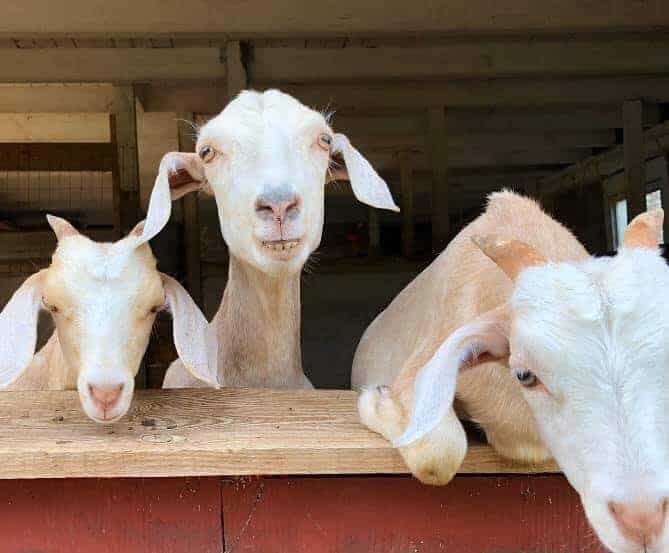
Photo: Lancaster Farm Sanctuary
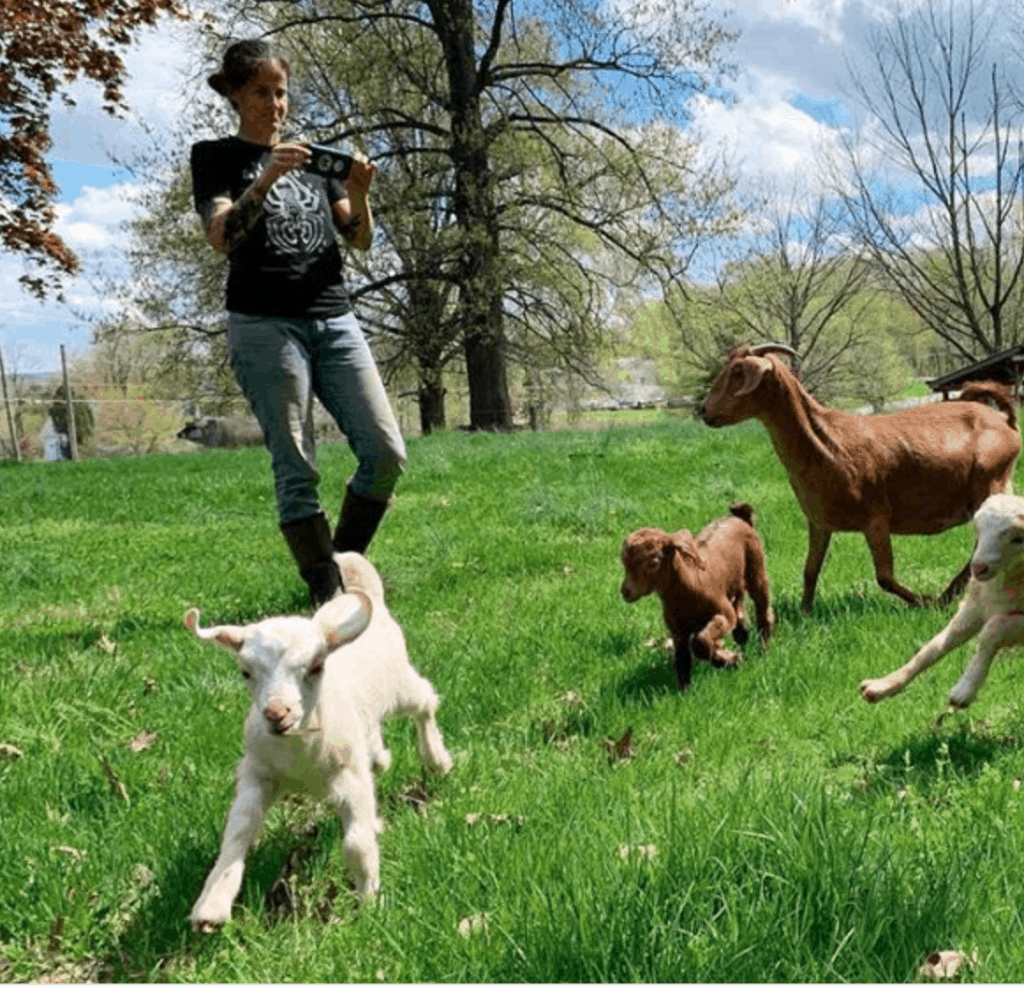
Photo: Lancaster Farm Sanctuary
Physical Enrichment
Physical or structural enrichment refers to creating a dynamic living space for residents. This is where you should think about what your resident as a species and individual would want in a living space. Check out our Animal-Centered Design resource to learn more about this. Let’s look at some goat-specific physical enrichment:
- Providing multiple water and food “stations”.
- Provide different piles of substrate like fresh dirt, piles of leaves, or goat-safe mulch.
- Mounds, old trees, goat-safe bushes etc…
- Set up self grooming stations.
- Rock features to climb upon.
- Provide stumps, large rocks, large spools, and wooden platforms to allow climbing behavior.
- Partition their outdoor living space and rotate where they have access to.
- Add new features to their environment on a schedule.
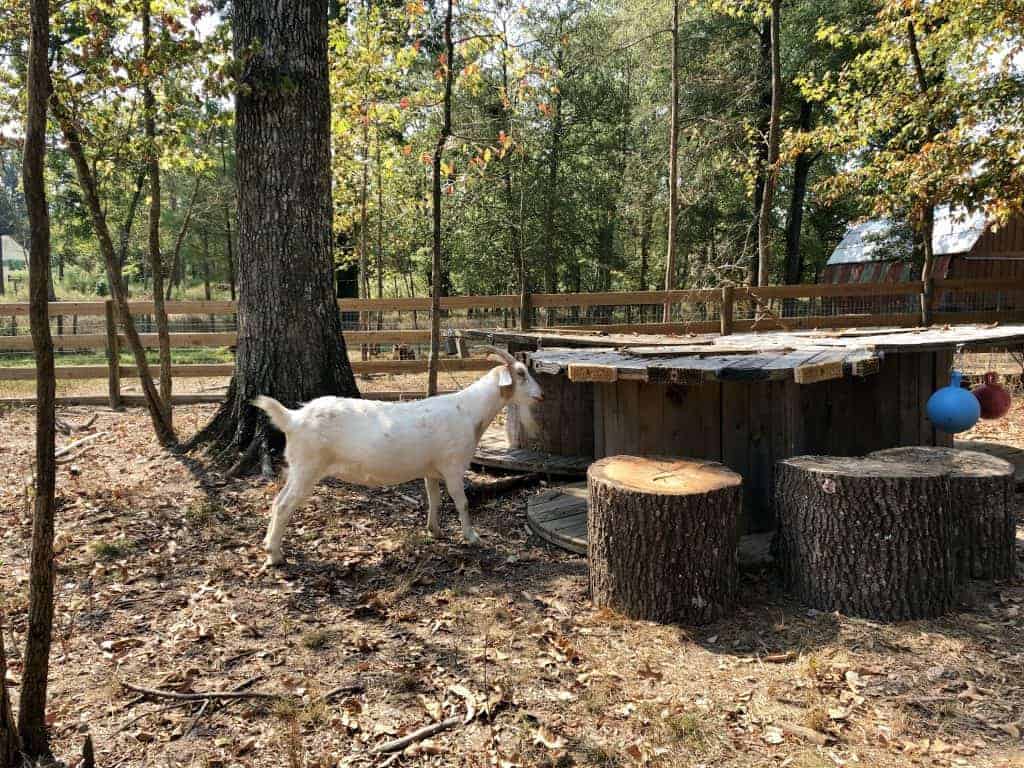
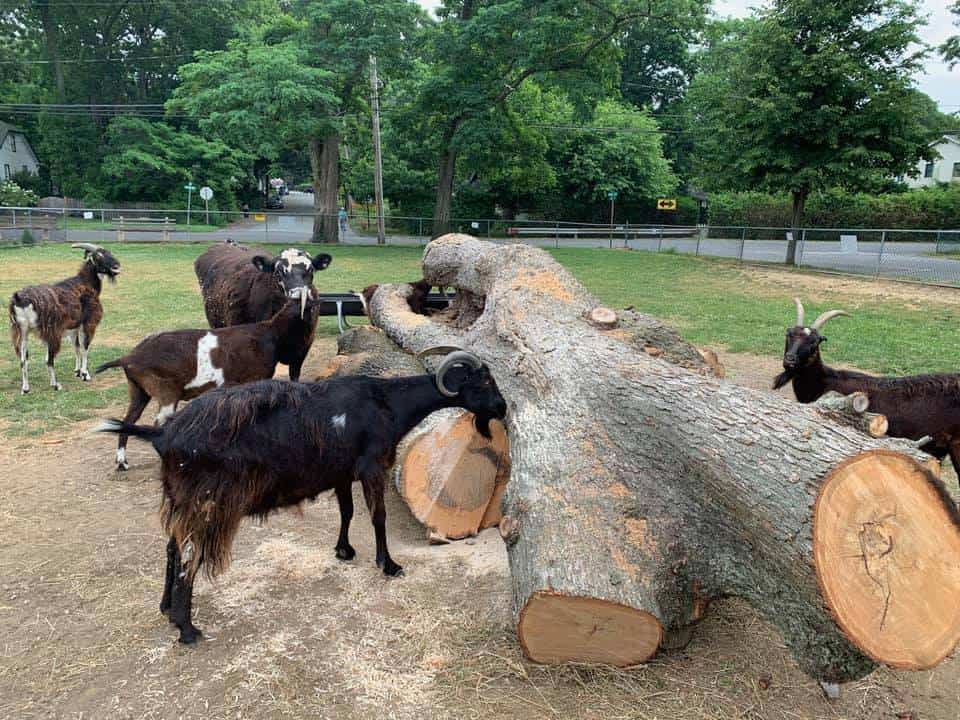
Lewis Oliver Farm Sanctuary
Nutritional Enrichment
Goats revel in taste testing whatever they can get their mouths on, they enjoy reaching for tasty leaves, and they love exploring their spaces for an array of tasty treats. Check out our resource on safe treats for goat residents here!
Here is a list of nutritional enrichment strategies for your goat residents:
- Take a PVC pipe and put caps on the ends. The length of the tube can be a foot long or larger. Drill a handful of holes on the side of the tube, and it becomes a food dispenser. You can attach these dispensers to a fence or post, put leafy greens through them, and hang them at different heights to stimulate natural browsing behaviors. Additionally, you can even make PVC “tree branches” and hang them from a ceiling, from goat furniture, or an actual tree!
- Another option is to place goats food in wiffle balls or other goat-safe treat balls. As the balls roll, treats fall out.
- In the summer, chop up goat-safe treats and freeze them into a big container filled with water for a treat that keeps on giving! This has the added bonus of helping residents stay cool.
- Some puzzle feeders made for dogs can be used for goat residents with supervision.
- Hang hay feeders and branches to encourage movement and browsing behavior.
- Hollow out a pumpkin and put treats inside.
- Gather a pile of leaves (be sure they aren’t toxic) and sprinkle treats throughout.
- String produce and make a garland to hang in their living space. If you do implement garlands, regularly make sure that goat residents do not chew through the string, as this could cause harm to them!
As a species, goats have exhibited a behavior called contrafreeloading. Contrafreeloading means an animal will choose to perform a task to receive food or another resource, even when there is food readily available.
If you think hiding a goat’s food or making them work for their food is teasing or they don’t like it, you should try an experiment: Set out a puzzle with food in it next to a bowl of food and see where your goat residents migrate to!
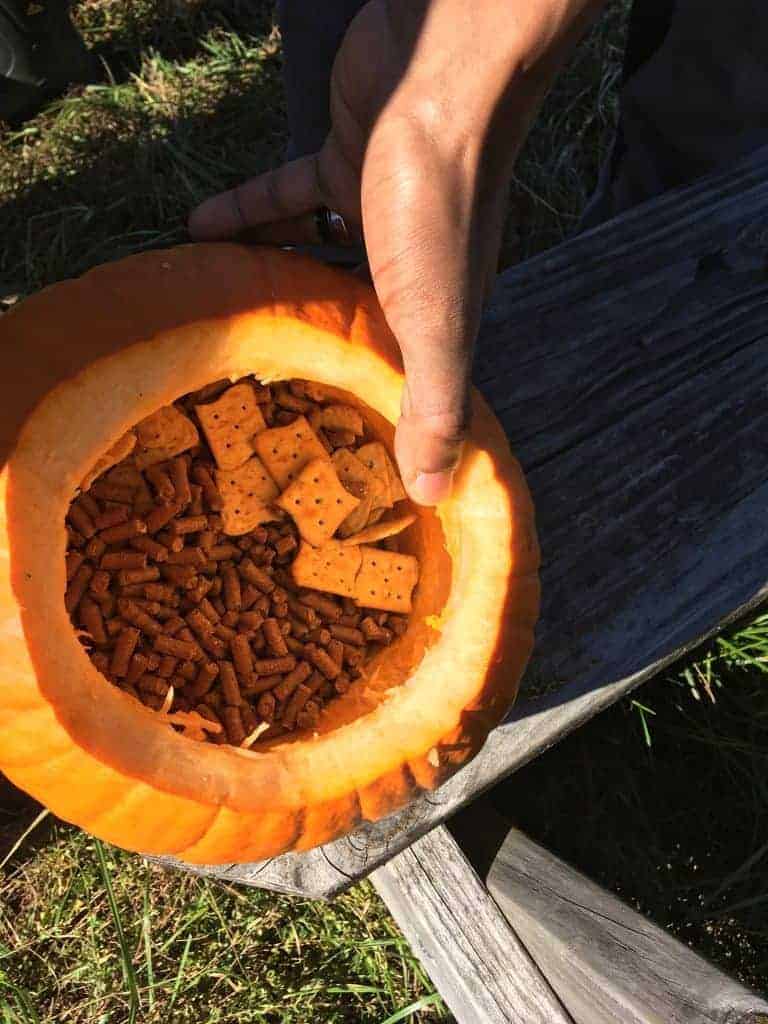
Sensory Enrichment
Sensory enrichment refers to enrichment that engages the senses. Arguably all enrichment engages the senses, but sensory enrichment focuses in on sight, touch, hearing, and smell. Each can provide interesting experiences for residents!
Visual Enrichment
Goats can also benefit from visual forms of enrichment. There is some anecdotal evidence that some goats may find moving images engaging. Potential visual enrichment strategies for goats may include:
- Displaying computer screen savers, particularly those that move.
- Showing television programs or movies, especially for isolated goat residents.
- In other species, images of the same species has been projected onto walls and shown to promote behavioral imitation among the social group. Therefore, projecting scenes of happy goats may help your resident goats feel good too. Interest in images can fade after a few weeks, so they should be changed routinely to sustain interest.
- Provide mirrors, or in the case of goats, reflective polished metal surfaces. If you choose to implement this, observe the residents carefully. This may not be an ideal form of enrichment for them if they exhibit confrontational behaviors.
- Adding new, brightly colored, goat-safe things to the environment can encourage their natural curiosity and safe exploration of their living spaces. This may include traffic cones, balls, or even large stuffed animals! As long as goats do not fear the objects or risk ingesting them, you can add anything that may be visually interesting and appealing and observe their reactions to ensure it’s a positive addition.
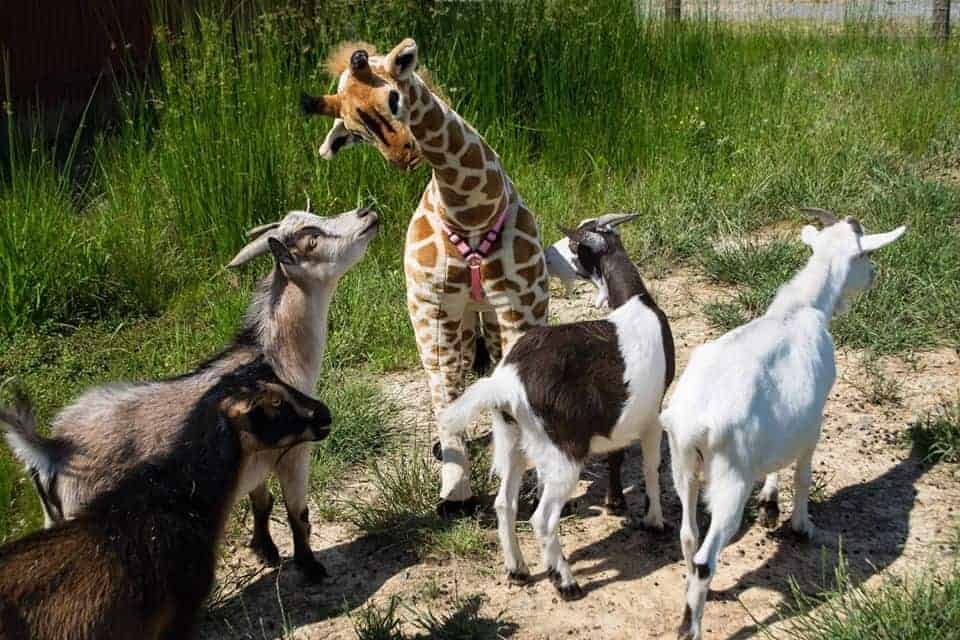
Photo: Piedmont Farm Animal Refuge
Olfactory Enrichment
Olfactory enrichment is often overlooked when considering goats. However, goats are a curious bunch and often explore their environment through sniffing and tasting things before deciding to eat them! Examples of olfactory enrichment strategies for goats may include:
- If you need to transfer a goat to a new living space, add a bit of soiled bedding from their previous space for a familiar scent that may make the adjustment a bit easier.
- Rub goat safe-herbs in different areas or place them in feeding devices.
- Use goat-safe essential oils on different toys and see how individual goat residents respond.
- If introducing new goats to an existing herd, provide them each with some soiled bedding from the others’ area to become familiar with their scent.
Auditory Enrichment
Do you love a good tune? Or have a favorite song that soothes you? The same can be true for goats! Examples of auditory enrichment for goats may include:
- Try playing different music for goats for a limited period and observe their behaviors. Think about whether you’re hoping for certain increased or decreased activities, such as calm or playful behaviors, and ensure that the music choice supports the desired outcomes.
- If they are cooped up due to weather issues, try playing nature sounds, or the sounds of happy goats.
- Think about how the objects you add to their living spaces could provide not only tactile, visual, and olfactory stimulation, but auditory as well. Think of hanging bells, or piping that they can make noise with or a large, goat-safe bamboo wind chime! As always, ensure that goats cannot accidentally ingest any objects!
- If you want to get really creative, you could get a skilled technician to install a large button of sorts that plays music or sounds for a short amount of time if pressed by residents!
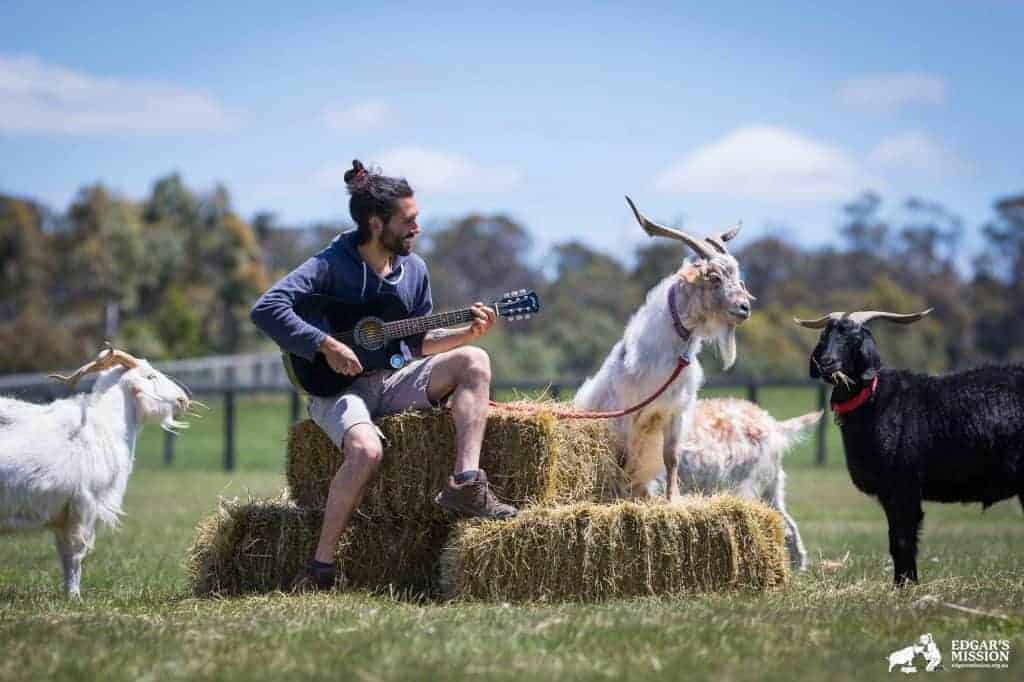
Photo: Edgar’s Mission Farm Sanctuary
Tactile Enrichment
To encourage goats to interact with their environment and redirect otherwise problematic behavior, consider implementing tactile enrichment strategies in their living spaces. Remember, goats love to climb and explore! Examples of tactile enrichment strategies for goats may include:
- Add goat furniture! This may include playgrounds, mounds of dirt or stone, tractor tires (either half buried to encourage climbing, or place on their side and filled with dirt for a nice cool bed), see saws, balance beams, old large spools, goat swings, and old stumps. A lot of these things can be found for free on Craigslist and Facebook Marketplace, as well as local free or swap groups like Freecycle.
- Make a scratching post by attaching large brushes to posts for a nice way for them to scratch that itch! Natural untreated plant-based bristle broom heads can be an excellent choice.
- Add various types of goat-safe brush and vegetation to goat resident outdoor living spaces.
- Add sand, dirt, or other substrates that provide a different feeling when walked on or lain upon.
- Add large stuffed animals, balls, fallen trees, paper maché, or anything else that provides various textures to explore. As always, ensure that goats cannot accidentally ingest any objects or parts of them!

Photo: Edgar’s MissionThe stated goals and activities of an organization. An animal sanctuary’s mission is commonly focused on objectives such as animal rescue and public advocacy. Farm Sanctuary
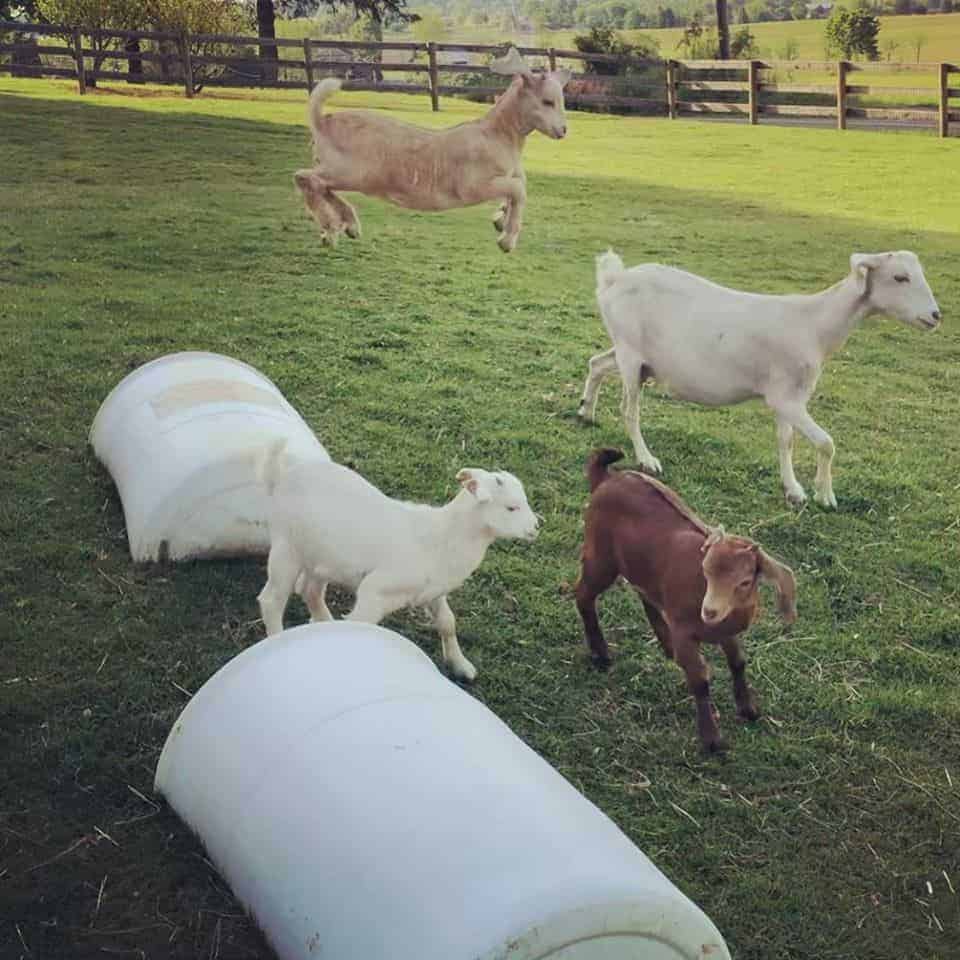
Photo: Lancaster Farm Sanctuary
Cognitive Enrichment
Cognitive enrichment involves experiences or environments that encourage curiosity, problem-solving behaviors, and learning. A number of enrichment strategies listed above also fall into this category. Puzzle feeders and engaging with curious things in their environment are examples. But let’s touch on another form of cognitive enrichment: positive reinforcement learning (This is often referred to as “training”, but we like to refer to it as clicker “learning”, “play” or “bonding”).
- Positive Reinforcement Engagement
- Many goat may enjoy interacting with their human caregivers. One way to build a strong human-goat bond and boost cognitive functioning in your goat residents is to engage in clicker “learning”. Clicker learning and positive reinforcement are not interchangeable words. However, a clicker can be a useful tool during positive reinforcement engagement!
- Examples of activities to learn with your goat residents could include learning to choose a specific shape or color of an object, rewarding them with an immediate click and treat. Other examples include learning to push a large ball or plastic barrel around or to even play “soccer” with you (exercise and engagement), ring a bell, open boxes, or even to ease fear or reactivity to medical procedures and transport. This external link provides a brief tutorial on how to engage horses with a clicker. This works for sheep too.
Focus On The Resident
It is important to note that clicker learning or play should only be implemented for the positive experiences that can be provided to your residents. This should not be used to encourage behavior that might be unsafe or exploitative.
Observe And Take Notes
Because every goat is an individual, they are likely to have individual responses to enrichment strategies. When you first add enrichment items, be sure to carefully observe the reactions of your residents. This is to ensure they are comfortable and not frightened, and also to ensure they aren’t eating any parts they shouldn’t be, such as brushes from scratching posts.
To prevent discomfort to new items or enrichment schedules, consider adding novel objects to an area on the side of their living space or in a space that doesn’t require them walking past the item to go inside, outside, or reach their water or food. If you believe one of your resident herds or individuals may be fearful of certain enrichment, encouraging them to investigate object while you are sitting and holding the object can help ease fears. Using food or treats to motivate them to interact with the item can be a great way to start. Giving your residents the option to engage or not with enrichment items can be empowering and improve emotional states. Be sure to make notes of any reactions in addition to when their level of interest seems to subside. This will help you know how to best schedule days to change up their enrichment and provide them with a mentally stimulating environment.
Novelty
Novelty can be an enrichment proffering on it’s own! Making changes to the “furniture,” arrangement, placement of food, addition of balls, toys, and swings, can all create an interesting an enriching environment for your goats residents. Goats are clever and curious and become bored after some time with provided enrichment. For this reason, it is important to incorporate “switch it up” days into your residents’ enrichment schedules. As mentioned above, it is important to take notes on herd and individual responses so you can properly tailor enrichment to the interests and needs of your residents.
Building A Schedule
Once you learn more about your residents’ interests, you can build an enrichment schedule to provide varying forms of enrichment as part of your caregiving routine. This will keep things interesting for the goats and help provide a stimulating and happy life for your residents.
Do you have an exciting enrichment strategy you use with your goat residents? Tell us all about it!
SOURCES:
The Right Pipe | Sandy McFadden
Loose Housing Of Small Goat Groups: Influence Of Visual Cover And Elevated Levels On Feeding, Resting, And Agonistic Behaviour | Applied Animal Behavior Science (Non-Compassionate Resource)
Goat Enrichment | The Enrichment Record (Non-Compassionate Source)
Outside Enclosure And Additional Enrichment For Dairy Goats – A Preliminary Study | Acta Veterinaria Scandinavia (Non-compassionate Source)
If a source includes the (Non-Compassionate Source) tag, it means that we do not endorse that particular source’s views about animals, even if some of their insights are valuable from a care perspective. See a more detailed explanation here.








